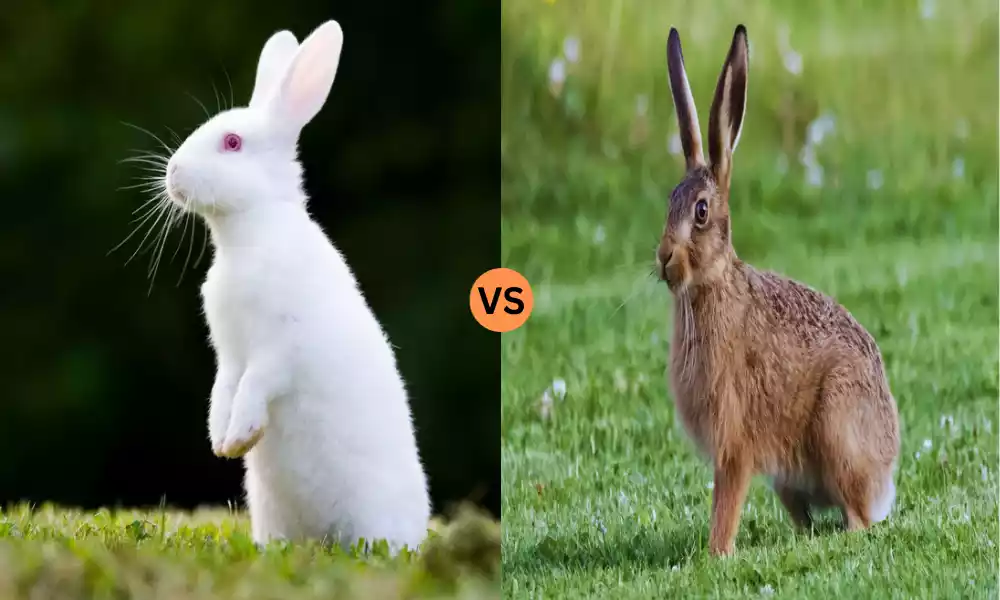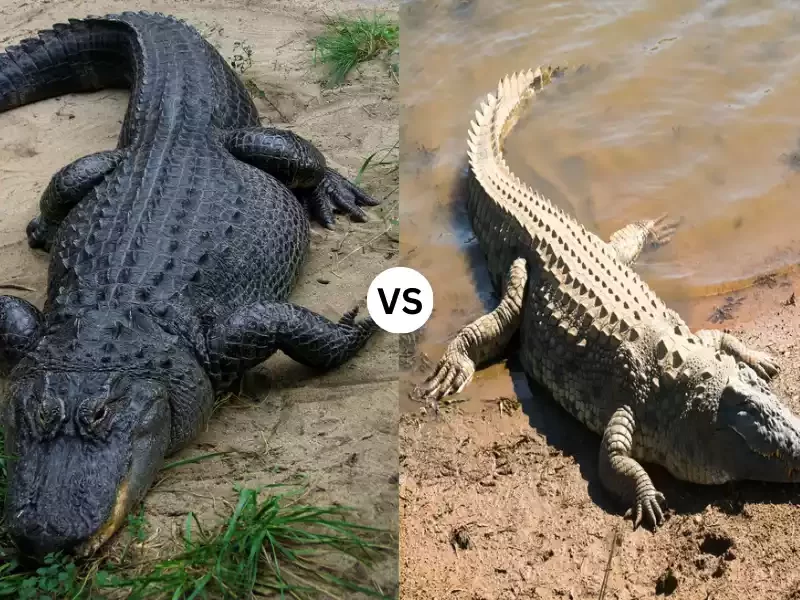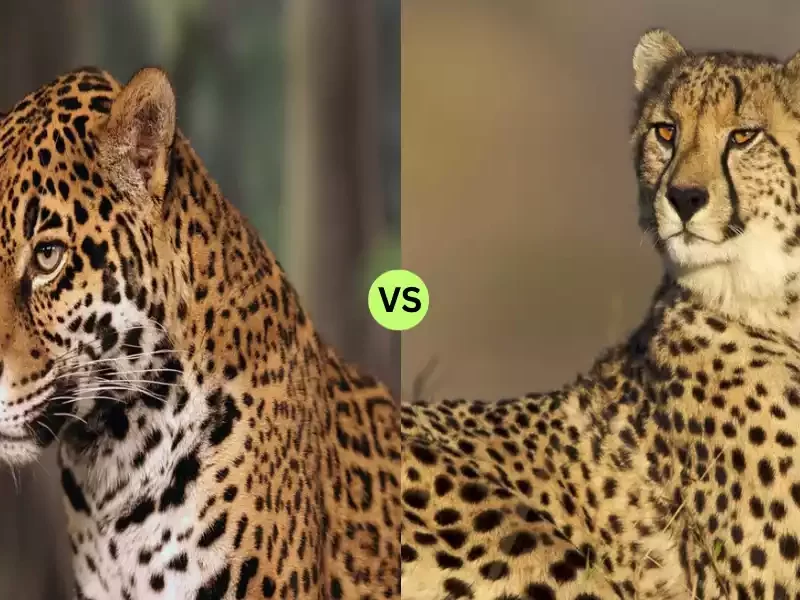Rabbit and Hare, while often confused with one another, are distinct species with unique characteristics and habits. Both belonging to the Leporidae family, these creatures play significant roles in ecosystems around the world. While they share certain physical similarities and are both herbivores, their distinctions in behavior, habitat, and physical attributes set them apart. We will delve deep into the differences between rabbits and hares, shedding light on their individual traits and the significance of understanding these distinctions.
Definition of Rabbit
A rabbit is a small to medium-sized mammal belonging to the family Leporidae, characterized by its long ears, short fluffy tail, and strong hind legs. It is known for its burrowing behavior and is found in various parts of the world. Typically herbivorous, rabbits have a diverse diet that includes grasses, leaves, and some fruits. Often kept as pets, rabbits are also reared for their meat and fur in various cultures. They have a significant presence in folklore, literature, and symbolism, often representing traits like vulnerability, innocence, and fertility.
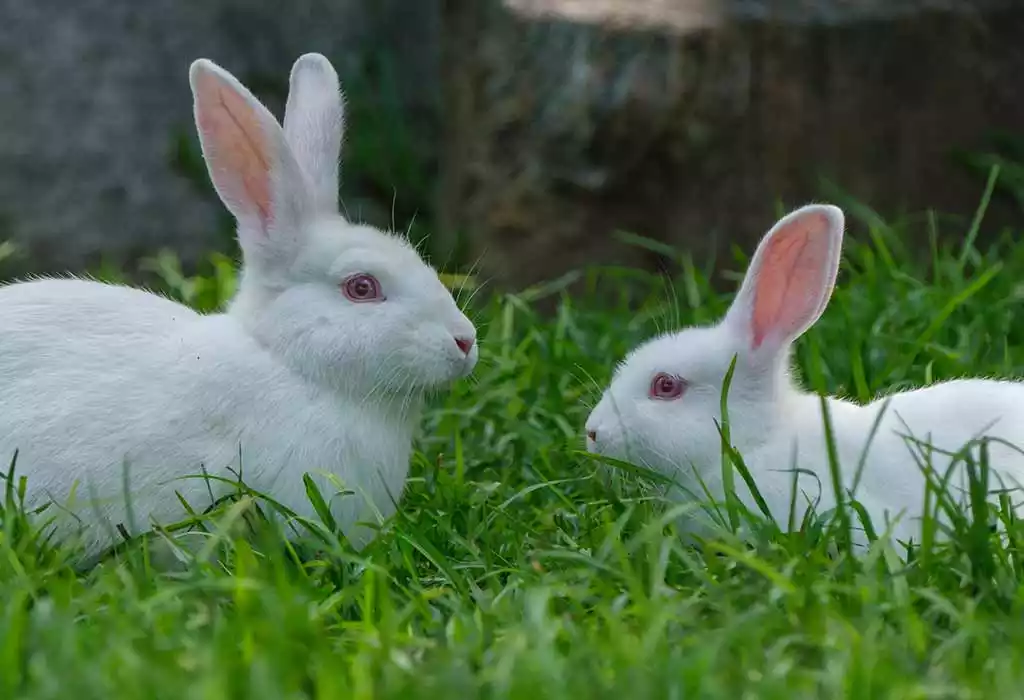
Physical character Rabbit
Physical Characteristics of a Rabbit:
- Size: Rabbits are generally small to medium-sized mammals, though the actual size can vary significantly based on the species.
- Ears: They have upright ears, which are relatively shorter compared to those of hares. The ears play a vital role in thermoregulation and hearing.
- Eyes: Rabbits have large eyes positioned on the sides of their head, giving them a broad field of view to detect predators.
- Body: They have a compact and rounded body.
- Legs: Rabbits have strong hind legs, which are shorter than those of hares. These legs are adapted for quick, short bursts of speed, mainly to dart to their burrows when threatened.
- Tail: Their tail is short, fluffy, and often resembles a cotton ball, leading to the colloquial term “cottontail” for some species.
- Fur: Rabbit fur is soft and dense. The color of their fur can vary widely, from white and gray to brown and black, depending on the species and sometimes the environment.
- Teeth: Like all members of the order Lagomorpha, rabbits have two sets of upper incisors. Their teeth grow continuously throughout their life, and the act of chewing food, especially fibrous material like hay, helps wear them down.
- Whiskers: Rabbits have sensitive whiskers that assist them in navigating their environment, especially in the dark confines of a burrow.
- Feet: Their feet are padded and can be quite large relative to body size, helping them move silently and quickly. The hind feet are longer than the front ones.
- Digestive System: Rabbits have a unique digestive system adapted to break down fibrous vegetation. They practice coprophagy, where they consume their soft, nutrient-rich feces to extract as much nutrition as possible from their food.
These characteristics can slightly vary depending on the specific rabbit species and whether the rabbit is wild or domesticated.
Definition of Hare
A hare is a medium to large-sized mammal, also belonging to the family Leporidae, distinguished by its powerful hind legs, long ears, and larger size compared to rabbits. Hares are adapted for high-speed endurance running, allowing them to escape from predators. Unlike rabbits, hares do not burrow but instead make a small nest called a “form” in tall grass or under bushes. Typically more solitary than rabbits, they are herbivorous and have a diet that varies based on their environment. Hares have a rich presence in various cultural, folklore, and mythological contexts, often symbolizing swiftness, wildness, and cunning.
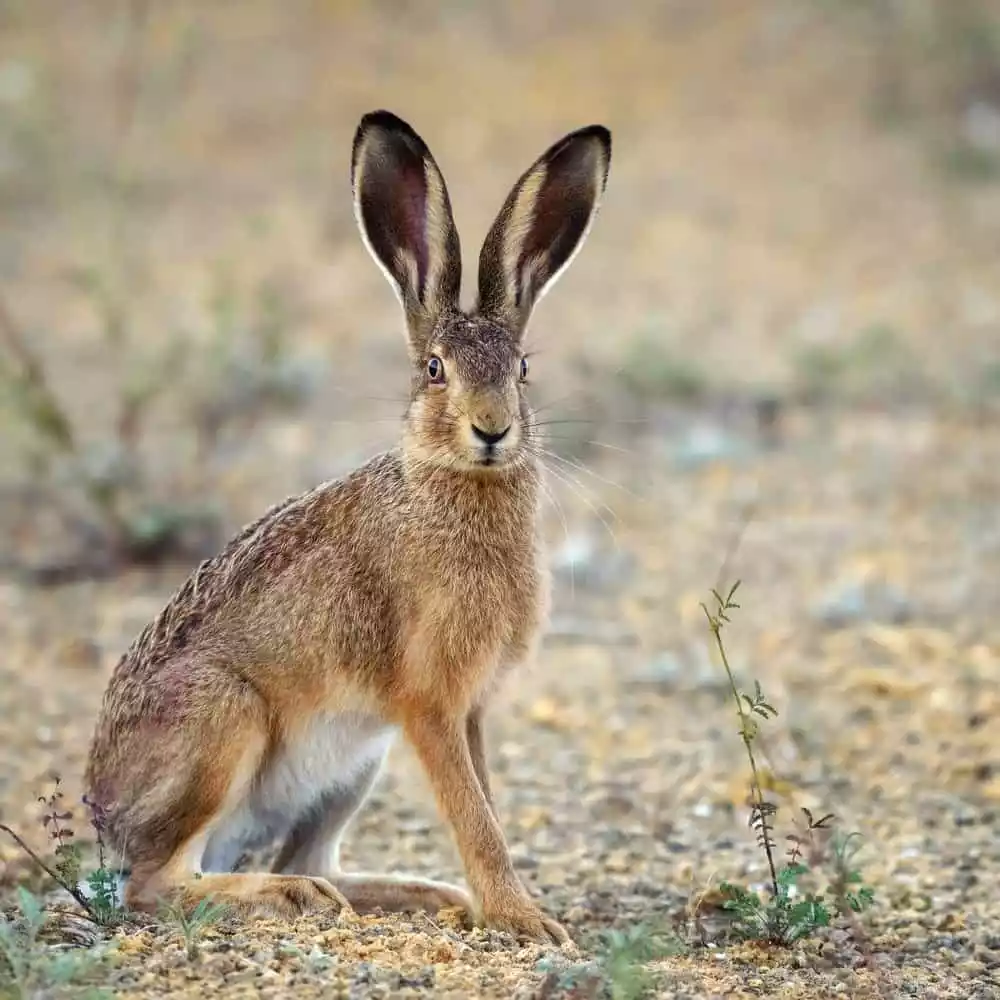
Physical character of Hare
Physical Characteristics of a Hare:
- Size: Hares are generally medium to large-sized mammals. Their size tends to be larger than most rabbit species.
- Ears: Hares have long, upright ears. In many species, such as the jackrabbit, the ears are particularly elongated, assisting in thermoregulation and enhanced hearing.
- Eyes: Similar to rabbits, hares have large eyes positioned on the sides of their heads, offering a wide field of view to spot predators.
- Body: Hares possess a more elongated, muscular, and athletic body compared to rabbits, suited for sustained high-speed running.
- Legs: Their hind legs are notably longer and stronger than those of rabbits. This allows hares to achieve remarkable speeds when evading predators.
- Tail: Hares have a slightly longer tail compared to rabbits, though it remains relatively short. The color often contrasts with the rest of the body, such as a black-topped tail.
- Fur: The fur of hares can be coarse and varies in coloration depending on the species and habitat. Some hares, like the snow hare, change fur color seasonally to camouflage with their environment.
- Teeth: Like rabbits, hares also have continuously growing teeth with two sets of upper incisors. Chewing on vegetation helps keep their teeth at the proper length.
- Whiskers: Hares have whiskers that aid in sensory perception and navigation, particularly useful during nocturnal activities.
- Feet: The feet of hares are large and well-adapted for sprinting. Their powerful hind feet allow them to make long leaps when running.
- Digestive System: Similar to rabbits, hares have a digestive system designed for a herbivorous diet and can also practice coprophagy to maximize nutrient absorption.
- Young Offspring: Unlike rabbits, hare leverets (young) are born fully furred and with their eyes open, a condition known as being precocial. This is an adaptation for their non-burrowing lifestyle, as the young need to be more self-sufficient soon after birth.
These characteristics, while general for hares, can vary among the different species and depending on the specific environments in which they reside.
Comparison table of Rabbit and Hare
| Feature | Rabbit | Hare |
|---|---|---|
| Taxonomic Family | Leporidae | Leporidae |
| Size | Small to medium-sized | Medium to large-sized |
| Ears | Relatively shorter | Longer, especially in some species like the jackrabbit |
| Legs | Strong, but shorter hind legs | Very powerful, longer hind legs |
| Living Habitats | Burrows | Forms (nests in tall grass or under bushes) |
| Social Behavior | Often social, may live in groups | Typically more solitary |
| Reproduction | Multiple litters per year, many offspring | Usually 1-2 litters per year, fewer offspring |
| Physical Appearance | Shorter, more compact body | Sleeker, more muscular body |
| Defensive Behavior | Tend to freeze or bolt to burrows | Rely on high-speed running to evade predators |
| Young at Birth | Altricial (blind and hairless) | Precocial (born with fur and open eyes) |
| Lifespan | Typically shorter (2-9 years, varies by species) | Generally longer, but varies by species |
| Domestication | Commonly domesticated as pets | Rarely domesticated |
| Diet | Grasses, leaves, and some fruits | Varied herbivorous diet, depends on environment |
| Cultural Significance | Symbols of vulnerability, innocence, fertility | Symbols of swiftness, wildness, and cunning |
There are multiple species of both rabbits and hares, and the specific characteristics can vary among them. The table provides a general overview.
Importance of distinguishing between Rabbit and Hare
Distinguishing between rabbits and hares is essential for various scientific, ecological, and cultural reasons. Here are some key points illustrating the importance of this distinction:
- Scientific Understanding:
- Taxonomy and Evolution: While both rabbits and hares belong to the Leporidae family, they have distinct evolutionary paths and represent different genera within the family. Understanding these differences aids in evolutionary biology and phylogenetics.
- Ecology and Conservation:
- Habitat Preservation: Rabbits and hares have different habitat preferences. While rabbits often prefer areas where they can burrow, hares are more inclined to open spaces. Recognizing these differences is crucial for habitat preservation and restoration efforts.
- Predator-Prey Dynamics: The behavior and physiology of rabbits and hares can influence local predator populations differently. For example, the burst speed of a rabbit might affect one set of predators, while the endurance run of a hare might influence another.
- Threats and Conservation Status: Some species of hares or rabbits might be more vulnerable to extinction than others. Proper identification ensures accurate conservation strategies.
- Cultural and Economic Relevance:
- Hunting: In regions where hunting is prevalent, understanding the difference between rabbits and hares is essential for setting hunting seasons, quotas, and sustainable hunting practices.
- Agriculture: Rabbits and hares can have varying impacts on agriculture. For instance, a farmer dealing with rabbit infestations might require different management strategies than for hares.
- Symbolism: In folklore and mythology, rabbits and hares might represent different things. For instance, the hare is often seen as a symbol of swiftness and cunning, while the rabbit might symbolize fertility and innocence.
- Pet Ownership and Animal Husbandry:
- Care Requirements: Domesticated rabbits have specific care requirements, vastly different from those of wild hares. Potential pet owners should be aware of the differences to ensure proper care.
- Breeding Practices: In animal husbandry, understanding the reproductive behaviors and needs of rabbits versus hares is crucial for sustainable and humane breeding practices.
- Educational Importance:
- Promoting accurate knowledge helps dispel myths and misconceptions about these animals. An educated public is more likely to make informed decisions related to wildlife and conservation.
Distinguishing between rabbits and hares is not just a matter of semantics. It plays a pivotal role in various areas ranging from science and conservation to culture and economics.
Habitat and Living Conditions of Rabbit and Hare
Both rabbits and hares have evolved to suit a variety of habitats across the world. Their specific living conditions and habits vary based on the species and the environment in which they’re found. Here’s a general overview of their habitats and living conditions:
Rabbits:
- Habitat:
- Rabbits are found in various habitats, including meadows, woods, grasslands, deserts, wetlands, and even suburban and urban areas.
- Domesticated rabbits, which are often kept as pets, live in controlled environments such as hutches, cages, or homes.
- Living Conditions:
- Burrows/Warrens: Many wild rabbit species are burrowers. They dig extensive underground tunnel systems known as warrens that provide protection from predators and harsh weather conditions. A warren can have multiple entrances and chambers.
- Nesting: Inside the burrows, female rabbits (does) create special nesting chambers lined with grass and fur to give birth and raise their young.
- Crepuscular Activity: Wild rabbits are generally crepuscular, meaning they are most active during the early morning and evening to avoid predators and the heat of the day.
Hares:
- Habitat:
- Hares are more adapted to open landscapes compared to rabbits. They inhabit grasslands, tundras, arctic regions, deserts, and open fields.
- Some species like the snowshoe hare are found in forests and snowy areas.
- Living Conditions:
- Forms: Unlike rabbits, hares do not dig burrows. Instead, they make a small nest-like depression in the ground or vegetation called a “form.” Forms provide minimal shelter but allow hares to lay low and hide from predators.
- Camouflage: Hares rely on their coat color to blend into their surroundings. For example, the snowshoe hare’s fur changes from brown in summer to white in winter to camouflage against the snow.
- Sprinters: If detected by a predator, hares rely on their exceptional speed and agility to escape. They’re built for rapid, powerful running.
- Precocial Offspring: Hares give birth in the open, usually in tall grass or other sheltered spots. Their young, called leverets, are born fully furred and with their eyes open, ready to move shortly after birth.
While both rabbits and hares are adaptable creatures found in a range of habitats worldwide, their specific living conditions and survival strategies differ markedly. Rabbits tend to rely more on burrows and warrens for protection, while hares use their speed, agility, and camouflage to navigate more open terrains.
Behavior and Traits
Both rabbits and hares have evolved specific behaviors and traits that aid their survival in various habitats. Here’s a breakdown of their general behavior and characteristics:
Rabbits:
Behavior:
- Burrowing: Wild rabbits often dig and live in burrows, creating complex tunnel systems known as warrens. This behavior offers them protection from predators and environmental extremes.
- Crepuscular: Rabbits are typically most active during dawn and dusk. These crepuscular habits help them avoid daytime predators and the heat of the day.
- Thumping: When sensing danger, rabbits often thump their powerful hind legs on the ground, serving as an alarm signal for other rabbits.
- Grooming: Rabbits frequently groom themselves and others, cleaning their fur with their tongues and paws.
- Coprophagy: Rabbits eat certain types of their feces (cecotropes) to reabsorb essential nutrients. This behavior is vital for their digestive health.
Traits
- Compact Body: They generally have a rounded, compact body shape.
- Short Tail: The tail is short and fluffy, often resembling a cotton ball.
- Ears: Rabbits have upright ears that vary in size across species but are typically shorter than those of hares.
- Teeth: Like all members of the Leporidae family, rabbits have continuously growing teeth that they keep trimmed by chewing on vegetation and rough materials.
Hares:
Behavior:
- Running: When faced with predators, hares rely on their speed and agility. They can reach remarkable speeds and make sudden direction changes to evade threats.
- Freezing: Hares often freeze to blend into their surroundings when they sense danger, using their fur as camouflage.
- Solo Living: Hares are generally more solitary than rabbits, with less social structure.
- Forms: Instead of burrows, hares make a small depression in the ground or grass called a “form” where they rest and hide.
- Nocturnal: Some hare species are more active at night, avoiding predators and the heat of the day.
Traits
- Larger Size: Hares tend to be larger than rabbits, with a more elongated body.
- Long Legs: Hares have powerful, long hind legs adapted for sprinting.
- Ears: Hares typically have longer ears compared to rabbits, with some species having black tips.
- Precocial Offspring: Hare leverets are born fully furred and with eyes open, ready to move soon after birth.
While there are some overlapping behaviors and traits, both rabbits and hares have evolved specific strategies and characteristics that suit their respective environments and lifestyles.
Reproduction and Life Cycle
Reproduction and life cycles differ between rabbits and hares, reflecting their unique evolutionary strategies and environmental adaptations. Here’s a comparison of their reproductive behaviors and life cycles:
Rabbits:
Reproduction:
- Mating: Rabbits can start reproducing at a young age, sometimes as early as 3 to 4 months for certain breeds.
- Breeding Season: While domestic rabbits can breed year-round, wild rabbits usually have specific breeding seasons, often in the spring and summer.
- Gestation Period: On average, the gestation period for rabbits is between 28 to 31 days.
- Multiple Litters: A single female rabbit (doe) can have multiple litters in a year, sometimes up to five or more.
Life Cycle:
- Birth: Rabbits are altricial, meaning they are born hairless, blind, and completely dependent on their mother.
- Nesting: The doe creates a nest using fur, grass, and hay where she gives birth and cares for her young, known as kits or kittens.
- Development: The kits open their eyes after about ten days and begin exploring outside the nest shortly after. They start consuming solid food within a few weeks but continue nursing for around 6 to 8 weeks.
- Independence: By 4 to 5 weeks, young rabbits are usually weaned and start becoming more independent. They become sexually mature in a few months.
- Lifespan: Wild rabbits generally live for about 1 to 2 years due to various natural threats, while domesticated rabbits can live anywhere from 5 to 10+ years with proper care.
Hares:
Reproduction:
- Mating: Hares typically become sexually mature slightly later than rabbits, around 8 months to a year, depending on the species.
- Breeding Season: Most hares have seasonal breeding periods, though this can vary based on the species and its environment.
- Gestation Period: The gestation period for hares is a bit longer than rabbits, generally around 42 days.
Life Cycle:
- Birth: Hares are precocial, meaning they are born fully furred with their eyes open and are relatively mobile shortly after birth.
- Forms: Instead of nests, the mother hare (doe) gives birth in a simple depression on the ground called a “form.”
- Development: Leverets, as baby hares are called, start feeding on vegetation within a few days but will also nurse from their mother for a few weeks.
- Independence: Hares grow rapidly and are weaned by around 4 weeks. They quickly gain independence and move away from their birthplace.
- Lifespan: Hares in the wild typically have a lifespan of 3 to 5 years, although many don’t survive their first year. This can vary depending on the species and environmental factors.
Both rabbits and hares have evolved reproductive strategies that maximize their chances of survival in the wild. While rabbits give birth to helpless offspring but protect them in burrows, hares have fewer offspring, but they are born more developed and ready to face their environment.
Conclusion
Rabbits and hares, while both belonging to the Leporidae family and sharing some superficial resemblances, exhibit distinct differences in physical characteristics, habitats, and behavior. Rabbits, with their compact bodies, are burrowers that create intricate underground warrens for protection and are found in diverse environments from woods to urban areas. Hares, on the other hand, are built for speed in open terrains, making simple nests called “forms” rather than burrows, and have young that are more self-reliant shortly after birth. Understanding these differences is crucial for taxonomy, ecology, and even human interactions with these fascinating creatures.

